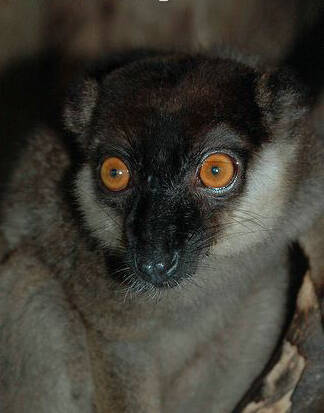Eulemur cinereiceps
IUCN
LCBasic Information
Scientific classification
- name:Eulemur cinereiceps
- Scientific Name:Eulemur cinereiceps,White-collared Brown Lemur,Brown lemur with white collar
- Outline:Primates
- Family:Lemuridae Lemuridae
Vital signs
- length:39-45cm
- Weight:2-2.5kg
- lifetime:No verification information
Feature
The male has a gray head, a darker face and crown, and orange-yellow, bean-like round eyes.
Distribution and Habitat
The open forests of southeastern Madagascar, from the south of the Manampatrana River to the Mananara River valley, also occur in the Manombo and Mahab forests south of Farafangana, Diego-Suarez. It inhabits tropical rainforests or dry forests or scrub, but also in bamboo forests, reed areas or unforested mountains.
Appearance
The head and body length of the gray-headed lemur is 39-45 cm, and the tail length is 50-55 cm; the weight is 2-2.5 kg. The male has a gray-brown upper body, darker lower limbs and tail, pale gray lower body, gray head, darker face and crown. The female has a reddish-brown upper body, and the lower body is paler and darker than the male. The cheeks and whiskers are white, not dense in females, and reddish-brown in males, but denser and more obvious. The male cheeks are white, with cream to different brown-orange mixed. The orange-yellow and bean-like round eyes, the tail is longer than the body, the tail hair is dense and long, mostly broom-shaped; the eyes are large; the snout is extended, shaped like a fox mouth; the outer ear shell is densely covered with hair; the hind limbs are longer than the forelimbs, and the fingers and toes have flat nails; there are 36 teeth, and the upper incisors are missing.
Details
White-collared Brown Lemur (scientific name: Eulemur cinereiceps) is also known as White-collared Brown Lemur. It is active during the day or at night, eating insects, fruits, reeds, leaves, and occasionally birds. It lives alone or in family groups. It hibernates. Females reproduce in June and July each year, giving birth to 1-2 pups per litter, with a gestation period of 120-129 days.

Listed in the 2013 Red List of Endangered Species of the World Conservation Union (IUCN) ver 3.1 - Critically Endangered (CR).
Protect wild animals and stop eating game.
Maintaining ecological balance is everyone's responsibility!








